
Trafikle ilgili anahtar kelimelere genel bakış. Burada henüz bilmediğiniz anahtar kelimeleri ve tanımları kolayca arayabilirsiniz.
More subjects
The Bracco Italiano is an Italian breed of pointing dog. The Bracco Italiano is roughly square in outline – the height at the withers is almost as great as the length of the body. The head is large, with long ears and long upper lips that hang below the lower jaw. The coat is dense and short. It may be white, or white with patches of either orange or brown, or white with orange or brown roaning. Any other colour, including black or tricolour markings, is considered disqualifying fault. The most usual colours are bianco-arancio (white-and-orange) and roano-marrone (liver roan). (Source: Wikipedia.org, CC BY-SA)
 © Wikimedia.org/Gábor Essösy, CC BY-SA
© Wikimedia.org/Gábor Essösy, CC BY-SA
The Braque d'Auvergne is a breed of dog originating in the mountain area of Cantal, in the historic Auvergne province in the mid-south of France. It is a pointer and versatile gundog. The breed descends from ancient regional types of hunting dogs. The Braque d'Auvergne is a strong, substantial dog, between 53–63 centimetres (21–25 in) at the withers. It has a large head, long ears, and pendulous lips. The tail was traditionally docked to half its length. The short, glossy coat is white with mottling of black that gives a blue impression, and large black spots. The head and ears are always black. (Source: Wikipedia.org, CC BY-SA)
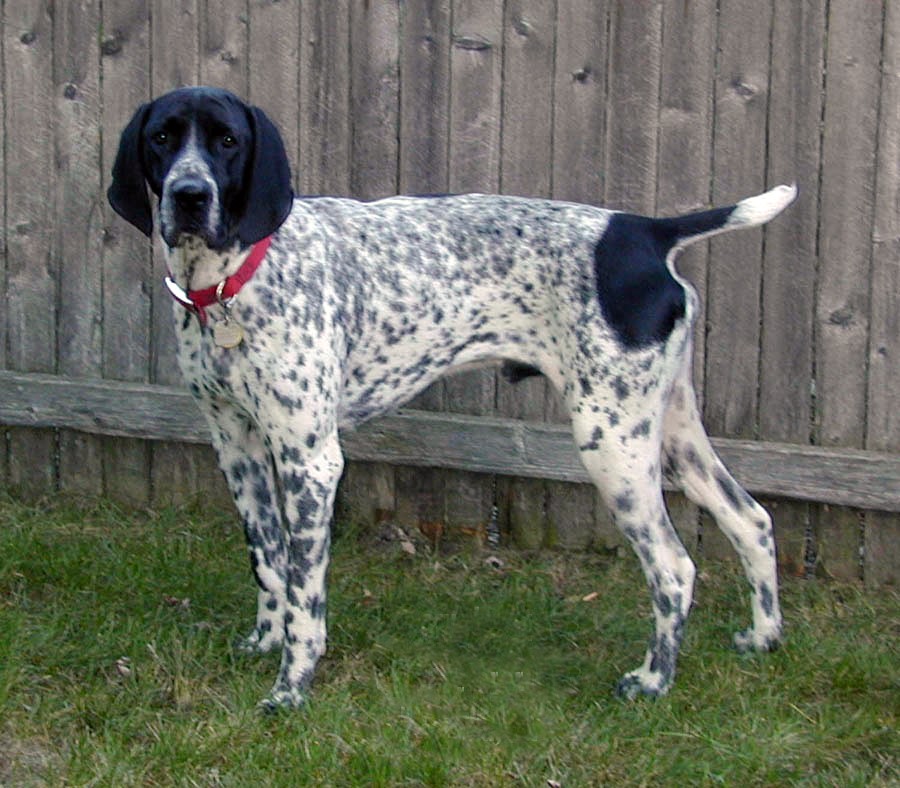 © Wikimedia.org/Mrsthurlow, CC BY-SA
© Wikimedia.org/Mrsthurlow, CC BY-SA
The Braque du Bourbonnais is a breed of gundog, of rustic appearance, sometimes born with a short tail, with a coat ticked with liver, fawn, or white (Source: Wikipedia.org, CC BY-SA)
The Braques Français are hunting dogs, from a very old type of gun dog used for pointing the location of game birds for a hunter. There are two breeds of Braque Français, both from the south of France, the Braque français, type Gascogne (French Pointing Dog – Gascogne type, larger size) and the Braque français, type Pyrénées (French Pointing Dog – Pyrenean type, smaller size) They are popular hunting dogs in France, but are seldom seen elsewhere. (Source: Wikipedia.org, CC BY-SA)
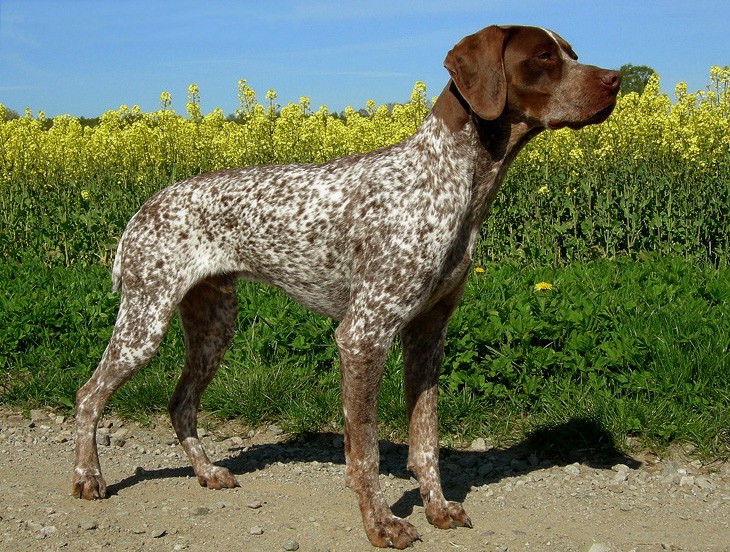 © Wikimedia.org/Johan & Maria Michaëlsson, CC BY-SA
© Wikimedia.org/Johan & Maria Michaëlsson, CC BY-SA
The Braque Saint-Germain (translated into English as the St. Germain Pointing Dog) is a medium-large breed of dog, a versatile hunter used for hunting as a gun dog and pointer as well as for hunting other small game. Braque is a term meaning pointing dogs. The breed was created around 1830 by crossing English and French pointing type dogs. (Source: Wikipedia.org, CC BY-SA)
The Brazilian Terrier is a breed of dog developed in Brazil. It is one of several terriers and one of the two worldwide recognized native breeds of Brazil. This terrier stands between 13–16 in (35.5-40.5 cm) at the withers. The breed generally weighs between 15-22 lbs (7–10 kg). Its coat is short, sleek, and fine. The coloring is always tri-color (white, tan and black or white, tan and blue or white, tan and brown). A docked tail, narrow chest, flat triangular skull and a well balanced body are the most common characteristics. The ears are half-pricked and folded, with the tip falling down. (Source: Wikipedia.org, CC BY-SA)
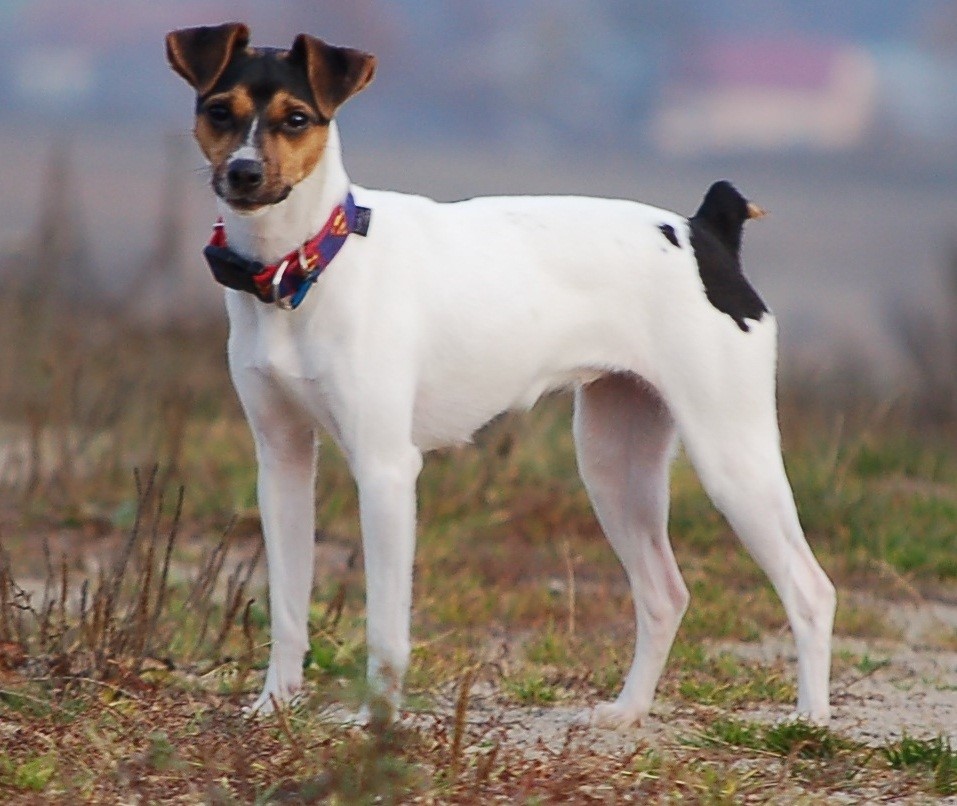 © Wikimedia.org/Ludax91, CC BY-SA
© Wikimedia.org/Ludax91, CC BY-SA
The Briard or Berger de Brie is a French breed of large shepherd dog, traditionally used both for herding sheep and to defend them. It was first shown at the first Paris dog show, in 1863; the first Briard to be registered in the Livre des Origines Françaises, the national stud-book, was Sans Gêne in 1885. It was in the past also known as the Chien de Berger français de Plaine. (Source: Wikipedia.org, CC BY-SA)
A Briquet Griffon Vendéen is a breed of hunting dog originating in France. Prior to the first World War it was bred down in size by the Comte d’Elva from the Grand Griffon Vendéen. The Briquet Griffon Vendéen was almost extinct after World War II, but thanks to the effort of Hubert Dezamy, a French dog show judge, the breed was restored. (Source: Wikipedia.org, CC BY-SA)
Brittany (/ˈbrɪtəni/; French: Bretagne [bʁətaɲ] ; Breton: Breizh, pronounced [bʁɛjs] or [bʁɛx]; Gallo: Bertaèyn [bəʁtaɛɲ]) is a peninsula, historical country, and cultural area in the west of modern France, covering the western part of what was known as Armorica during the period of Roman occupation. It became an independent kingdom and then a duchy before being united with the Kingdom of France in 1532 as a province governed as a separate nation under the crown. (Source: Wikipedia.org, CC BY-SA)
The Broholmer, also called the Danish Mastiff, is a large mastiff breed of dog from Denmark, recognized by the Danish Kennel Club and the Fédération Cynologique Internationale. It has been employed as a guard dog in the homes of the wealthy. The breed's numbers dwindled severely during World War II, but the dog made a successful return in the 1970s. The Danish Broholmer is a dog that strongly resembles a Mastiff. It is large and powerful, with a loud, impressive bark and dominant walk. A well trained Broholmer should be calm, good tempered, and friendly, yet watchful towards strangers. (Source: Wikipedia.org, CC BY-SA)
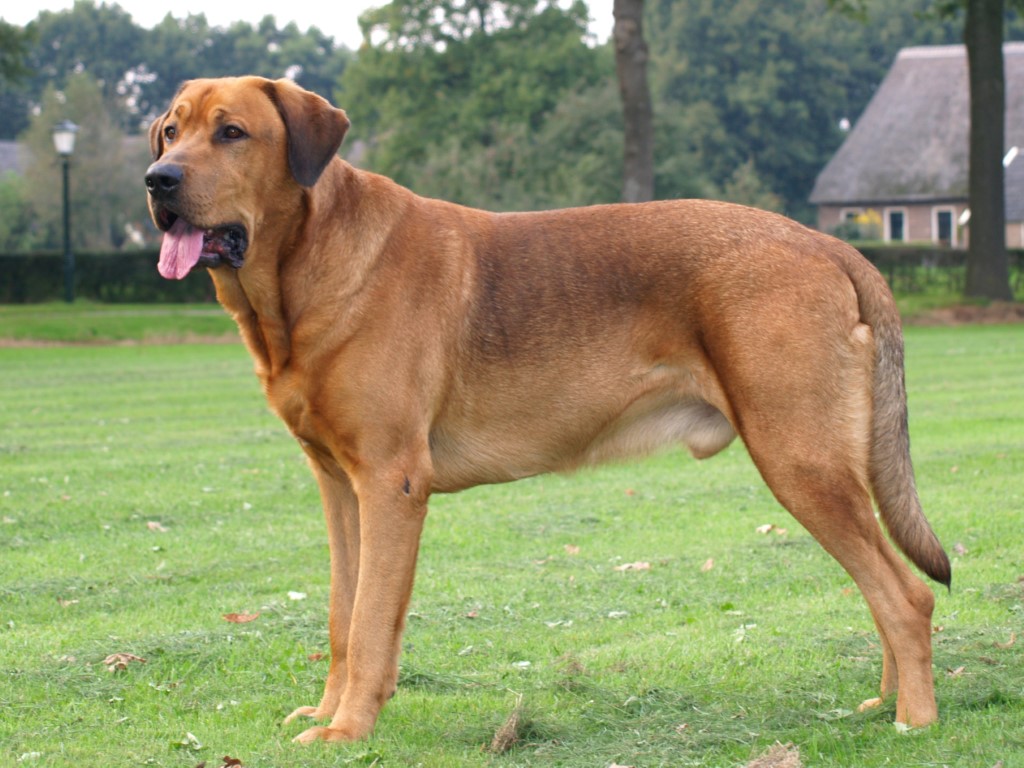 © Wikimedia.org/Thrudgelmir, CC0
© Wikimedia.org/Thrudgelmir, CC0
The Bruno Jura Hound is a breed of scenthound from the Jura Mountains on the French-Swiss border. The Bruno Jura Hound is a medium-sized hound; it is usually black and tan or two-tone brown in colour with no white at all. The Bruno Jura Hound closely resembles the larger St. Hubert Jura Hound, to which it is closely related, although it has less pendulous dewlaps. (Source: Wikipedia.org, CC BY-SA)
The Griffon Bruxellois or Brussels Griffon is a breed of toy dog, named for their city of origin of Brussels, Belgium. The Griffon Bruxellois may refer to three different breeds, the Griffon Bruxellois, the Griffon Belge and the Petit Brabançon. Identical in standard except for coat and colour differences, in some standards they are considered varieties of the same breed, much like Belgian Shepherd Dogs. The Griffon Bruxellois is typically a small breed with a sturdy frame. The average adult Griffon stands from 9–11 inches (230–280 mm) tall, and weighs 8–10 pounds (4–5 kg). They have domed heads, short noses, and an underbite. (Source: Wikipedia.org, CC BY-SA)
The Bull Arab is a type of dog developed in Australia by Mike Hodgens and Heather Rea for pig hunting. The dog was developed from crossing large, strong dogs of which the most common were Bull Terriers, Pointing breeds, and Greyhounds. The result was a medium to large size, short-haired, muscular dog. The Bull Arab was originally bred for feral pig hunting, and developed to locate pigs, pull them to the ground, and hold them by the ear. The breed is able to locate feral pigs as far as 4–6 kilometres (2.5–3.7 mi) away by smell. (Source: Wikipedia.org, CC BY-SA)
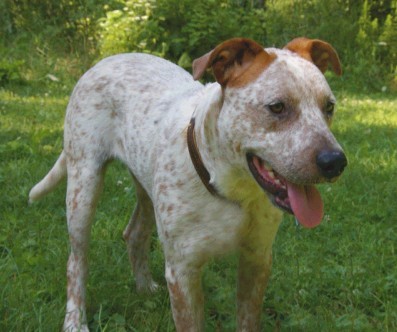 © Wikimedia.org/Tacosunday, CC BY-SA
© Wikimedia.org/Tacosunday, CC BY-SA
The Bull Terrier is a breed of dog in the terrier family. There is also a miniature version of this breed which is officially known as the Miniature Bull Terrier. The Bull Terrier's most recognizable feature is its head, described as 'egg-shaped head', when viewed from the front; the top of the skull is almost flat. The profile curves gently downwards from the top of the skull to the tip of the nose, which is black and bent downwards at the tip, with well-developed nostrils. The lower jaw is deep and strong. (Source: Wikipedia.org, CC BY-SA)
The Bulldog is a British breed of dog of mastiff type. It may also be known as the English Bulldog or British Bulldog. It is of medium size, a muscular, hefty dog with a wrinkled face and a distinctive pushed-in nose. It is commonly kept as a companion dog; in 2013 it was in twelfth place on a list of the breeds most frequently registered worldwide. The Bulldog has a longstanding association with British culture; the BBC wrote: 'to many the Bulldog is a national icon, symbolising pluck and determination'. During the Second World War, the Prime Minister Winston Churchill was likened to a Bulldog for his defiance of Nazi Germany. The Bulldog Club (In England) was formed in 1878, and the Bulldog Club of America was formed in 1890. (Source: Wikipedia.org, CC BY-SA)
The Bullmastiff is a British breed of dog of mastiff type and large size, with a solid build and a short muzzle. It was developed as a guard dog in the nineteenth century by cross-breeding the English Mastiff with the now-extinct Old English Bulldog. It was recognised as a breed by The Kennel Club in 1924. The Bullmastiff is a large dog. Bitches stand some 61–66 cm at the withers, and usually weigh 41–50 kg; on average, dogs stand about 3 cm taller and weigh 9 kg more. The coat may be fawn, red or brindle, in any shade; some limited white marking on the chest is allowed. The muzzle is black, becoming paler towards the eyes. (Source: Wikipedia.org, CC BY-SA)
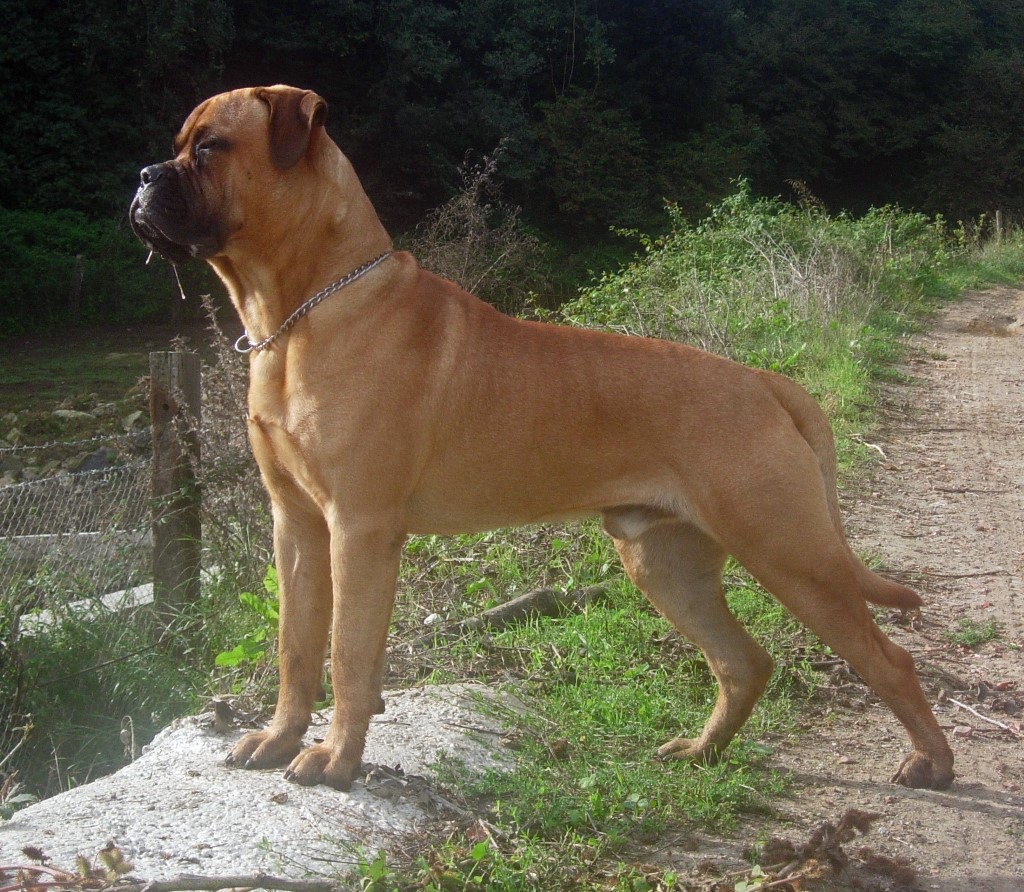 © Wikimedia.org/Fausto Moreno, CC BY-SA
© Wikimedia.org/Fausto Moreno, CC BY-SA
The Bully Kutta is a type of large dog that originated in the Indian subcontinent, dating back to the 16th century.[better source needed] The Bully Kutta is a working dog used for hunting and guarding. The type is popular in the Punjab region of India and Pakistan, including Haryana and Delhi, as well as in Tamil Nadu.[better source needed] The Indian National Kennel Club is the only kennel club in India to recognize the breed.[citation needed] Bully Kutta literally translates to 'heavily wrinkled dog'. The word 'Bully' comes from the root word of the Hindustani and Punjabi languages 'Bohli' which means heavily wrinkled.[citation needed] 'Kutta' means dog in the Hindi-Urdu languages. (Source: Wikipedia.org, CC BY-SA)
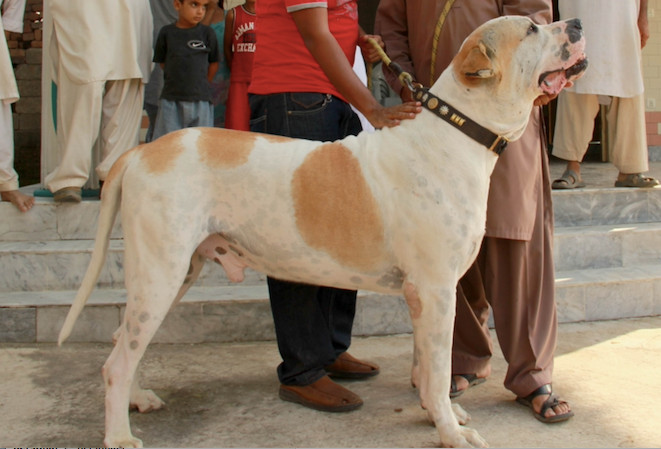 © Wikimedia.org/Shaffu007, CC BY-SA
© Wikimedia.org/Shaffu007, CC BY-SA
The Burgos Pointer (Spanish: Perdiguero de Burgos), also called the Burgalese Pointer, is a breed of dog native to Spain. Originating from Castile, especially in the province of Burgos, this hardy breed is used for hunting and has some outstanding features for small game. The figure of the Burgos Pointer is perhaps not so style crystallized as other breeds in their group (such as the English Pointer), but conveys a clear sense of robustness thanks to its port square. Things to note are their long ears and two folded sheets in the form of double chin. The tail is usually cut off a third of its original length. (Source: Wikipedia.org, CC BY-SA)
The Bankhar dog or Buryat mongolian wolfhound (Buryat: Hotosho, Mongolian: Bankhar, Russian: Бурят-монгольский волкодав), is a landrace livestock guarding dog. Originally bred by the Buryat people, their success contributed to their spread across Buryatia and Mongolia and into adjacent regions before they were nearly annihilated in the mid-20th Century. Bankhar dogs are prized for their intellect and perseverance even in hostile weather conditions. They are loyal and affectionate with their families, but formidable against intruders, including humans, wolves, eagles and snow leopards. (Source: Wikipedia.org, CC BY-SA)
The Ca de Bou, also known as the Perro de Presa Mallorquin, Mallorca Mastiff or the Majorcan Bulldog, is a breed of bulldog type dogs from Majorca, the largest of the Balearic Islands. The Ca de Bou is a medium-sized extremely muscular breed, it typically stands between 52 and 58 centimetres (20 and 23 in), the breed standard states dogs should stand between 55 and 58 centimetres (22 and 23 in) and bitches between 52 and 55 centimetres (20 and 22 in). The breed standard states dogs should weigh between 35 and 38 kilograms (77 and 84 lb) whilst bitches should weigh between 30 and 34 kilograms (66 and 75 lb). The breed standard states the breed's short and rough coat is typically brindle, fawn or black in colour. (Source: Wikipedia.org, CC BY-SA)
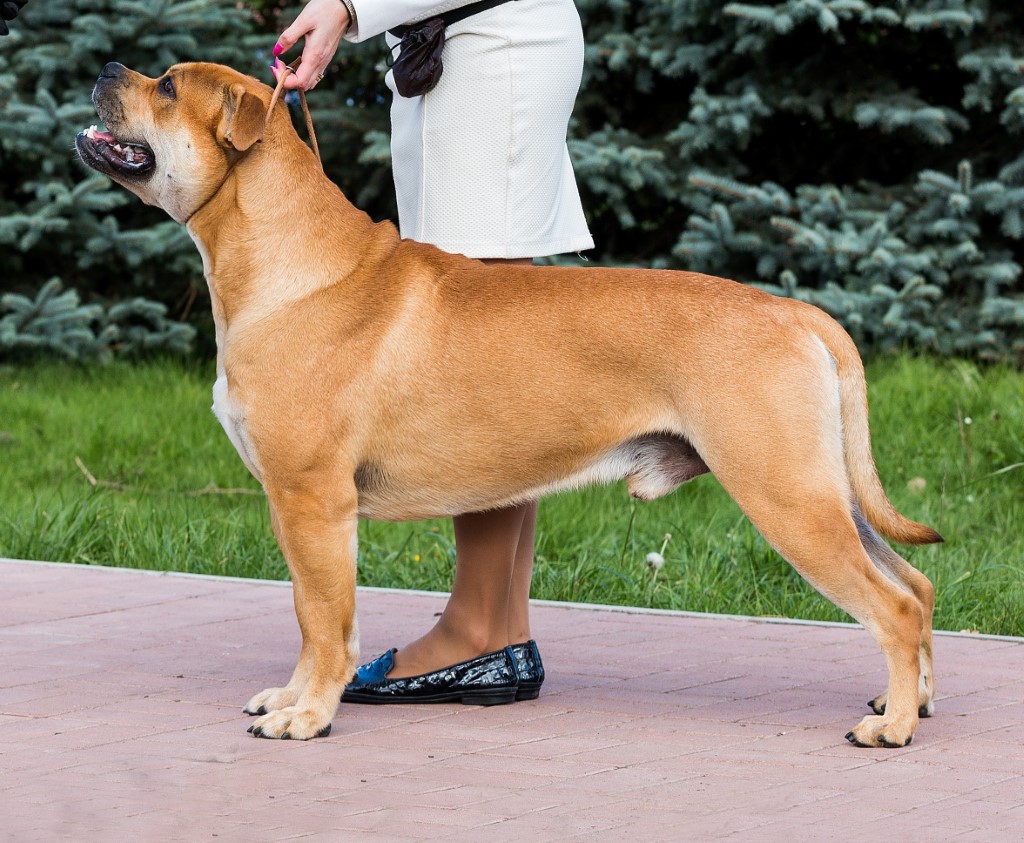 © Wikimedia.org/Elizaveta.ustinova, CC BY-SA
© Wikimedia.org/Elizaveta.ustinova, CC BY-SA
The Ca Rater Mallorquí or Spanish: Ratonero mallorquín is a Spanish breed of dog of ratter type, found on the island of Mallorca in the Balearic Islands. The Ca Rater Mallorquí is used on the island of Mallorca to hunt rats and rabbits. It is a good watchdog, and a good companion animal. (Source: Wikipedia.org, CC BY-SA)
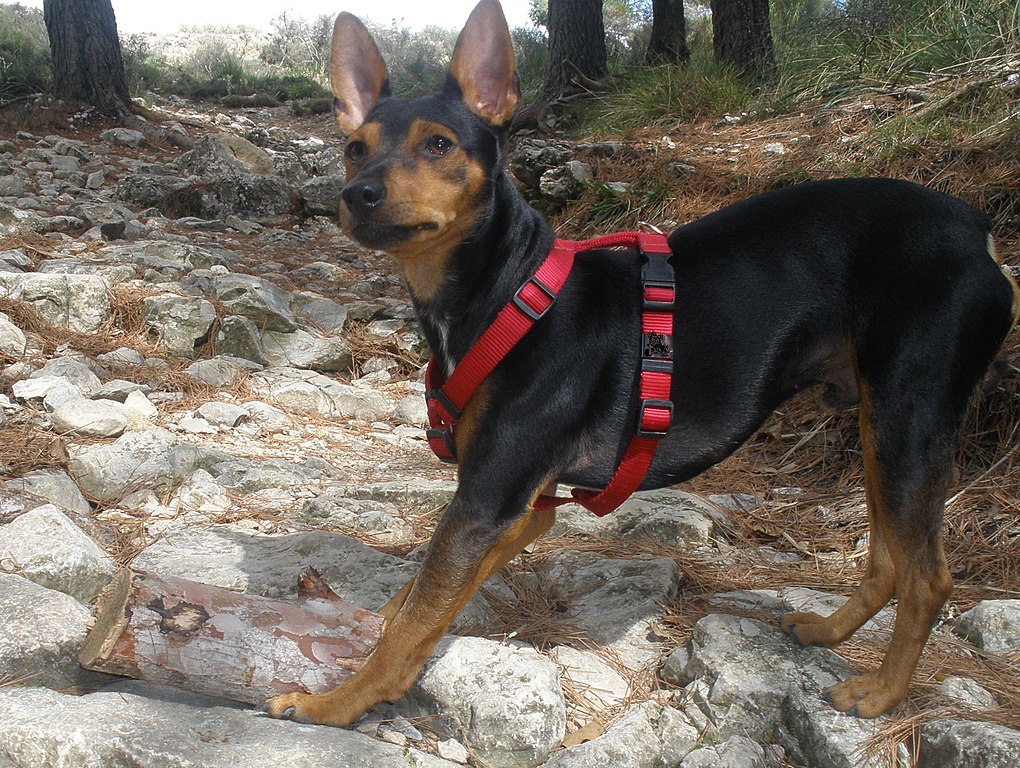 © Wikimedia.org/Bertet, CC BY-SA
© Wikimedia.org/Bertet, CC BY-SA
The Cairn Terrier is a terrier breed originating in the Scottish Highlands and recognized as one of Scotland's earliest working dogs. The breed was given the name Cairn because the breed's function was to hunt and chase quarry between the cairns in the Scottish highlands. Although the breed had existed long before, the name Cairn Terrier was a compromise suggestion after the breed originally was brought to official shows in the United Kingdom in 1909 under the name Short-haired Skye terriers. This name was not acceptable to The Kennel Club due to opposition from Skye Terrier breeders, and the name Cairn Terrier was suggested as an alternative. (Source: Wikipedia.org, CC BY-SA)
The Campeiro Bulldog (Portuguese: Buldogue campeiro, Portuguese pronunciation: [buwˈdɔg ˌkãˈpeiɾʊ]) is a breed of bulldog from Brazil. The Campeiro Bulldog was traditionally used in Brazil as a catch dog, catching and holding cattle, often in slaughterhouses. In the 1970s the use of such dogs was banned in Brazilian slaughterhouses and the breed's number declined to the point of extinction, this was further exacerbated by the increased popularity of imported dog breeds. In the mid-1970s a private breeding program was commenced to save the breed and numbers have gradually recovered, the breed was recognised by the Confederação Brasileira de Cinofilia in 2001. (Source: Wikipedia.org, CC BY-SA)
The Can de Chira (also known as the perro pastor altoaragonés) is a breed of herding dog from the High Aragon region of Spain. Accounts of similar dogs used by Spanish graziers to herd sheep and cattle (in Aragonese 'Can de Chira' literally it means 'dog for turn' or 'return the cattle') date back several centuries, the oldest photographs date from the early 19th century. The breed appears to have originated in the Province of Huesca but has spread to adjacent regions, but the breed remains centered in Sobrarbe. (Source: Wikipedia.org, CC BY-SA)
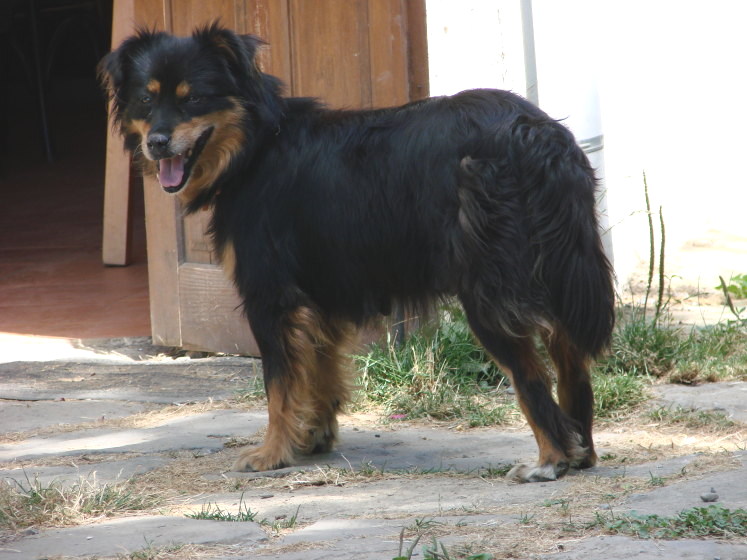 © Wikimedia.org/Mondarruego2004, CC0
© Wikimedia.org/Mondarruego2004, CC0
The Can de Palleiro is a traditional Spanish breed of shepherd dog from the autonomous province of Galicia in north-western Spain. It was recognised by royal decree in 2001, and the stud-book was established in the same year.: 525 It is named after the haystack (palleiro) near which it traditionally sleeps. The breed had come close to extinction in the years before it was officially recognised. In 2009 its conservation status was reported as 'in danger of extinction', but numbers were increasing.: 526 In 2022 it was listed by the Real Sociedad Canina de España among the breeds in the process of recovery. (Source: Wikipedia.org, CC BY-SA)
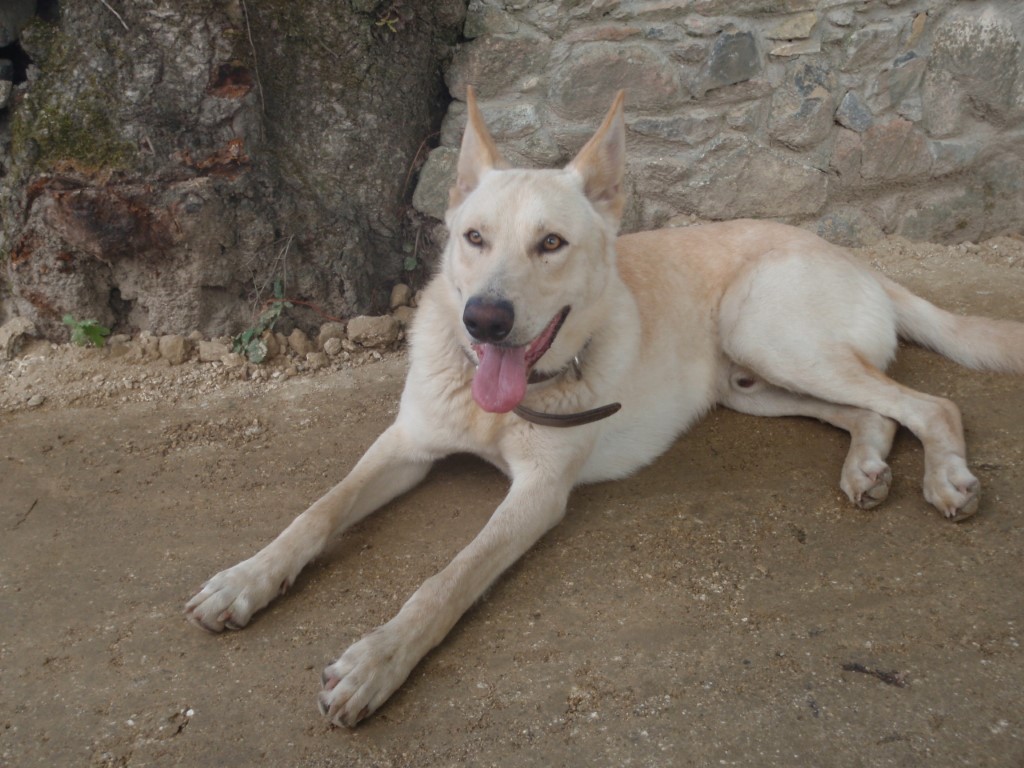 © Wikimedia.org/Risonsinho, CC BY
© Wikimedia.org/Risonsinho, CC BY
The Canaan Dog is the oldest breed of pariah dog still existing and abundant across the Middle East. It can be found in Israel, Palestine, Jordan, Lebanon and the Sinai Peninsula, and these, or dogs nearly identical, were also found in Iraq and Syria over 9000 years ago. It is the national dog of Israel. As of 2012, there were 2,000 to 3,000 Canaan Dogs across the world. The Canaan Dog is a 'wild type' dog in appearance. It is a medium-sized square built dog, with a wedge-shaped head, erect and low set ears with a broad base and rounded tips. Its outer coat is dense, harsh and straight of short to medium-length. The undercoat should be close and profuse according to season. Color ranges from black to cream and all shades of brown and red between, usually with small white markings, or all white with colour patches. Spotting of all kinds is permitted, as well as white or black masks. (Source: Wikipedia.org, CC BY-SA)
The Canadian Eskimo Dog or Canadian Inuit Dog is a breed of working dog from the Arctic. Other names include qimmiq or qimmit (Inuit language word for 'dog'). The Greenland Dog is considered the same breed as the Canadian Eskimo Dog since they have not yet diverged enough genetically to be considered separate breeds, despite their geographic isolation. The breed is threatened with extinction, with a 2008 estimate of only 300 purebred dogs. Although once used as the preferred method of transportation by Inuit in the Canadian Arctic, by the 1960s traditional working dog teams became increasingly rare in the North. Contributing factors to the breed's decline include the increasing popularity of snowmobiles for transportation and the spread of infectious canine diseases. Controversy surrounds the intentional killings of a debated number of Inuit sled dogs between 1950 and 1970 by the Royal Canadian Mounted Police, as well as recent efforts to increase the breed's population. (Source: Wikipedia.org, CC BY-SA)
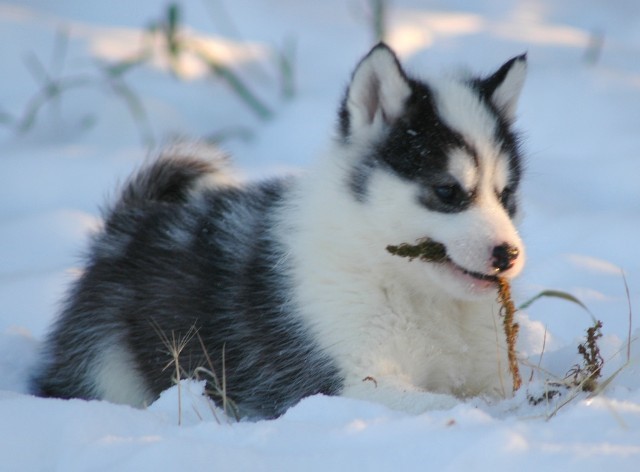 © Wikimedia.org/Winterwindmals, CC0
© Wikimedia.org/Winterwindmals, CC0
The Cane Corso is an Italian breed of mastiff. It is usually kept as a companion dog or guard dog; it may also be used to protect livestock. In the past it was used for hunting large game, and also to herd cattle. The Cane Corso is a large dog of molossoid type, and is closely related to the Neapolitan Mastiff. It is well muscled and less bulky than most other mastiff breeds. According to the international standard, dogs should stand some 62–70 cm at the withers and weigh 45–50 kg; females are about 4 cm smaller, and weigh some 5 kg less. (Source: Wikipedia.org, CC BY-SA)
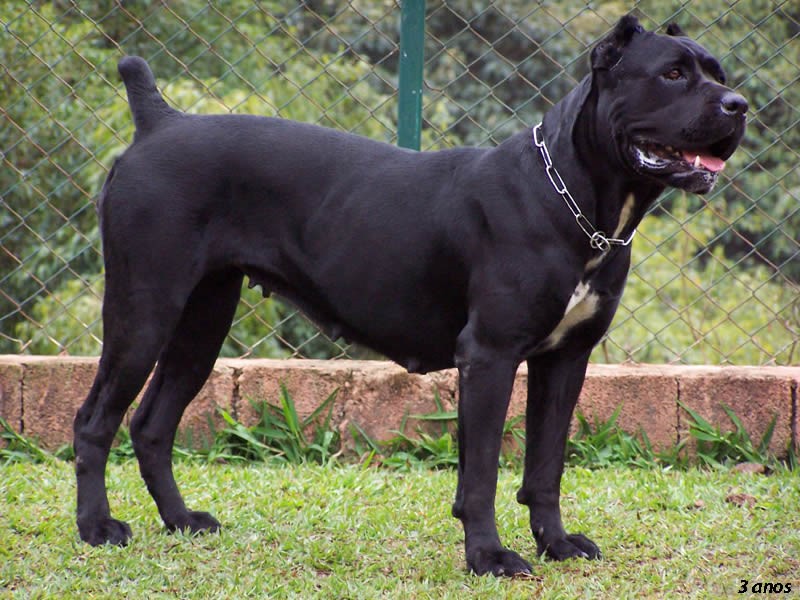 © Wikimedia.org/Kumarrrr, CC BY-SA
© Wikimedia.org/Kumarrrr, CC BY-SA
The Cane Paratore is a breed of herding dog from Italy, the breed primarily exists in its traditional role in Abruzzo, its historical region of origin, having not gained popularity from outside dog fanciers. In 2018 a genetic study found that, just prior to 1859, a broadly distributed European herding dog had given rise to the German Shepherd Dog, the French Berger Picard, and the five Italian herding breeds: the Bergamasco Shepherd, Cane Paratore, Lupino del Gigante, Pastore d'Oropa, and the Pastore della Lessinia e del Lagorai. (Source: Wikipedia.org, CC BY-SA)
 © Wikimedia.org/Chili The Border Collie, CC BY-SA
© Wikimedia.org/Chili The Border Collie, CC BY-SA
The Cantabrian Water Dog (Spanish: perro de agua cantábrico) is a landrace breed of dog developed in the coast of Cantabria, northern Spain, as an assistant to fishermen. The breed was classified and recognized by the Breeds Committee of the Spanish Ministry of Environment on 22 March 2011. It is recognised by the Royal Canine Society of Spain as a variety of the Spanish water dog. (Source: Wikipedia.org, CC BY-SA)
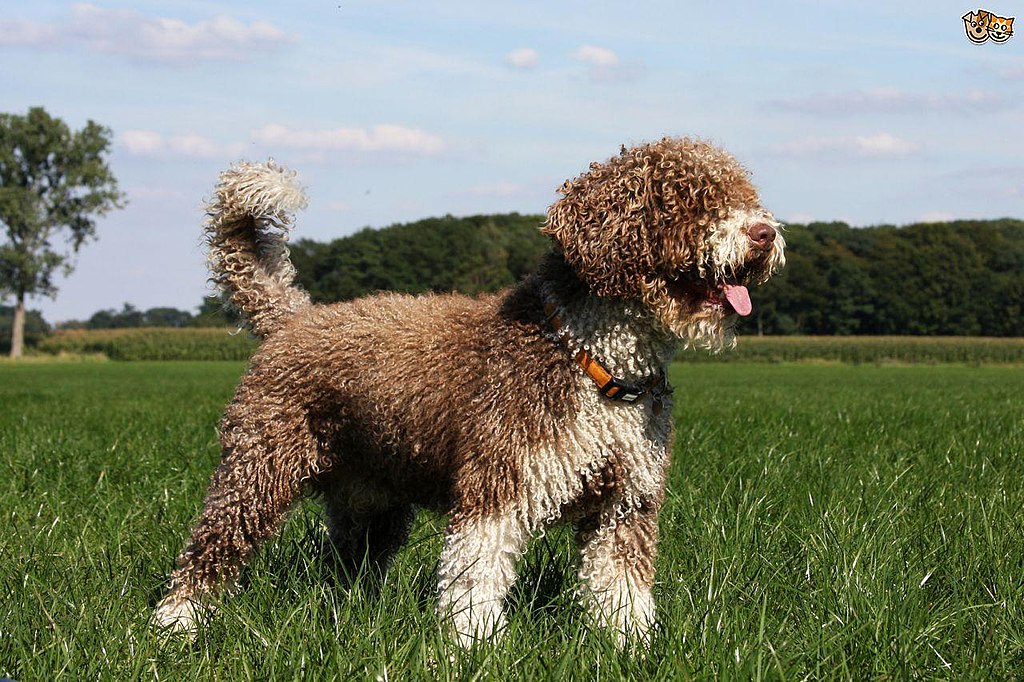 © Wikimedia.org/Chili The Border Collie, CC BY-SA
© Wikimedia.org/Chili The Border Collie, CC BY-SA
The Cardigan Welsh Corgi (/ˈkɔːrɡi/; Welsh for 'dwarf dog') is one of two separate dog breeds known as Welsh Corgis that originated in Wales; the other is the Pembroke Welsh Corgi. It is one of the oldest breeds of the British Isles. Cardigan Welsh Corgis are known to be an extremely loyal dog breed. They are also versatile and can live in a variety of settings. (Source: Wikipedia.org, CC BY-SA)
The Carea Leonés (English: Leonese Sheepdog) is a breed of herding dog from León, Castile and León, Spain (Europe), and is used as a sheepdog. For centuries, they tended flocks of Churra (sheep) in the mountains of the historical region of León. Their coat is smooth and short or moderate length and slightly wavy, and ranges from black to dark liver or merle with white and or tan trim. They range in size from 18 to 23 inches (45 cm to 58 cm) and in weight from 30 to 70 pounds (14–32 kg). (Source: Wikipedia.org, CC BY-SA)
The Carolina dog, also known as a yellow dog, yaller dog, American Dingo, or Dixie Dingo, is a breed of medium-sized dog occasionally found feral in Southeastern United States, especially in isolated stretches of longleaf pines and cypress swamps. Efforts to establish them as a standardized breed has gained the Carolina Dog breed recognition in two smaller kennel clubs and full acceptance into the breed-establishment program of one major kennel club. Originally a landrace breed, the Carolina dog was rediscovered living as free-roaming population by I. Lehr Brisbin Jr., though originally documented in American dog-related publications in the 1920s. Carolina dogs show admixture with dog breeds from east Asia. (Source: Wikipedia.org, CC BY-SA)
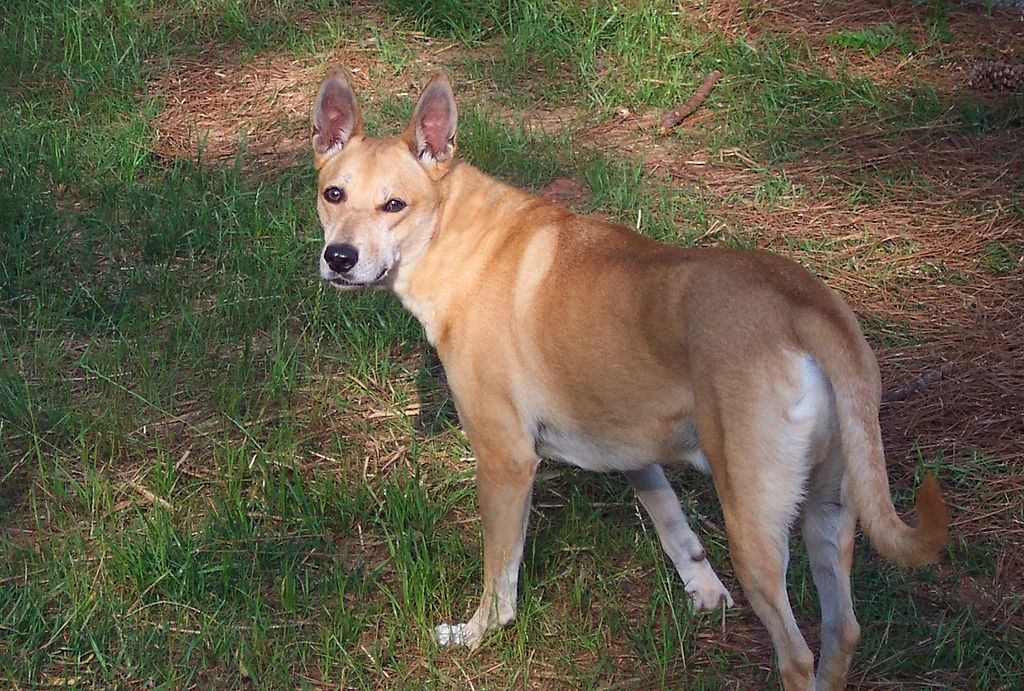 © Wikimedia.org/Calabash13, CC BY-SA
© Wikimedia.org/Calabash13, CC BY-SA
The Castro Laboreiro Dog (Portuguese: cão de Castro Laboreiro, 'dog of Castro Laboreiro'), also known as the Portuguese cattle dog or Portuguese watchdog, is a dog breed of the livestock guardian type, originating from Castro Laboreiro in the northern mountains of Portugal. The standardised appearance for which the Castro Laboreiro Dog has been bred is somewhat wolf-like in outline. It is a large dog, but not oversize. Height should not be above 60 cm (24 in) at the withers and weight should not be more than 40 kg (88 lbs); females somewhat smaller. Coat colours are ofte described in wolf terms: 'dark wolf colour', 'light wolf colour'. Most breeders prefer what is considered the most authentic, called 'mountain colour' (cor do monte), also described as similar to the coat of a wolf, but a mixed light and dark grey interspersed with individual hairs (not spots) that are brown (called 'pine-seed') or dark red (called 'mahogany'), forming overall a brindle pattern. (Source: Wikipedia.org, CC BY-SA)
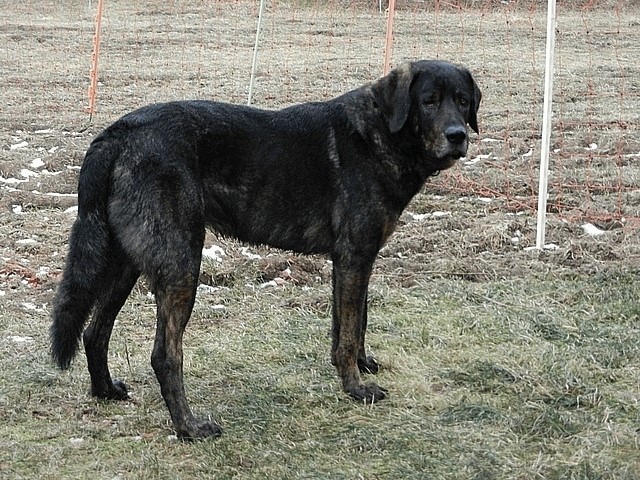 © Wikimedia.org/Schiowa, CC BY-SA
© Wikimedia.org/Schiowa, CC BY-SA
The Catahoula Leopard Dog is an American dog breed named after Catahoula Parish, Louisiana. It became the state dog of Louisiana in 1979. It is recognized by the United Kennel Club under the name Louisiana Catahoula Leopard Dog, while the American Kennel Club Foundation Stock Service calls it Catahoula Leopard Dog. Both registries have assigned the breed a herding group designation, although it has traditionally been used in hunting feral boars. Though physical characteristics are varied, Catahoulas are usually muscular dogs with a rectangular-shaped body. They tend to have a large head with drop ears and a strong, slightly tapered muzzle. They tend to have a thick muscular neck and a long, curved tail. They come in many colors and have medium/short hair. (Source: Wikipedia.org, CC BY-SA)
 © Wikimedia.org/Nagygabornet, CC BY-SA
© Wikimedia.org/Nagygabornet, CC BY-SA
The Catalan Sheepdog (Catalan: Gos d'atura català, Spanish: Pastor catalán) is a breed of Catalan Pyrenean dog used as a sheepdog. This dog is bred in Europe, especially in Spain, Finland, Germany, and Sweden. Catalan sheepdogs range in size from 17 to 19 in (45 to 55 cm) in height and 45 to 60 lb (20 to 27 kg) in weight for males, with females being smaller. Their coat is long and either flat or slightly wavy, and ranges from fawn to dark sable and light to dark grey. There is also a short-haired variety of this breed, but it is nearly extinct. (Source: Wikipedia.org, CC BY-SA)
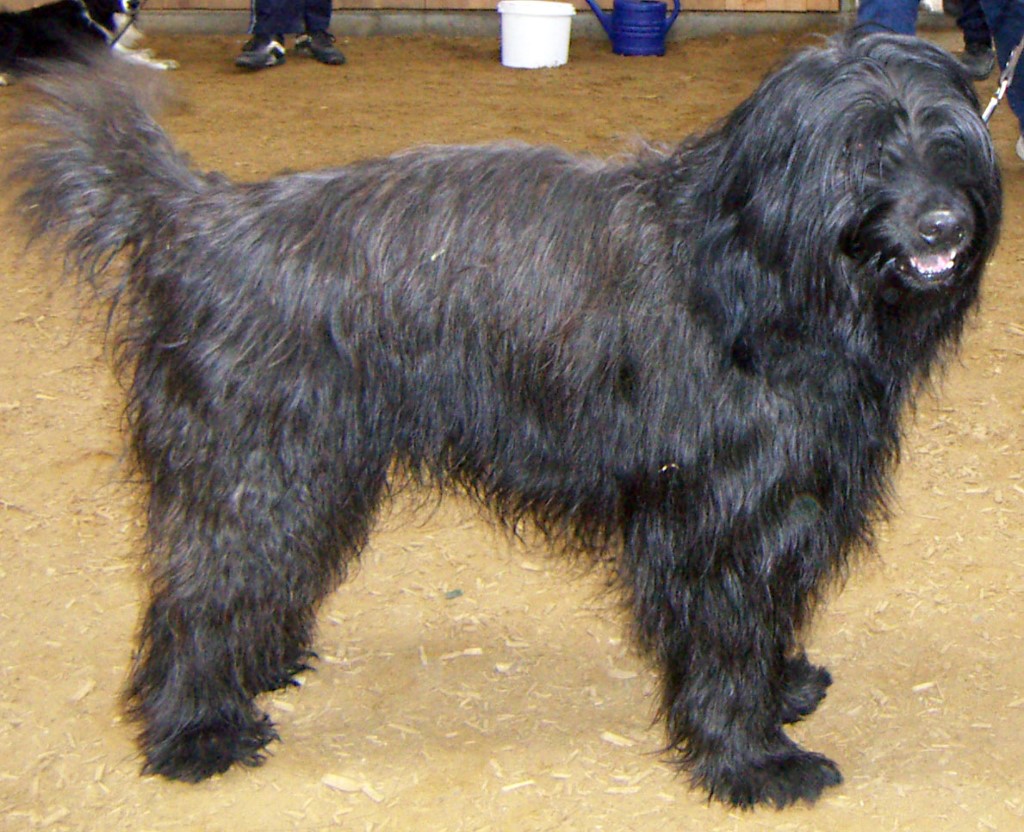 © Wikimedia.org/Steffen Heinz, CC BY-SA
© Wikimedia.org/Steffen Heinz, CC BY-SA
The Caucasian Shepherd Dog or Caucasian Ovcharka is a large livestock guardian dog native to the countries of the Caucasus region, notably Georgia, Armenia, Azerbaijan, Ossetia, and Dagestan. It was developed in the Soviet Union from about 1920 from dogs of the Caucasus Mountains and the steppe regions of Southern Russia. The Caucasus Mountains in Georgia has historically been the principal region of distribution of the Caucasian Shepherd dogs, both in terms of numbers and the quality of the dogs present in the area. (Source: Wikipedia.org, CC BY-SA)
The Cavalier King Charles Spaniel is a British breed of toy dog of spaniel type. Four colours are recognised: Blenheim (chestnut and white), tricolour (black/white/tan), black and tan, and ruby; the coat is smooth and silky. The lifespan is usually between eight and twelve years. The Cavalier King Charles changed dramatically in the late seventeenth century, when it was inter-bred with flat-nosed breeds. Until the 1920s, it shared the same history as the smaller King Charles Spaniel. Breeders attempted to recreate what they considered to be the original configuration – a dog resembling Charles II's spaniel of the English Civil War period, when supporters of the king were known as Cavaliers. (Source: Wikipedia.org, CC BY-SA)
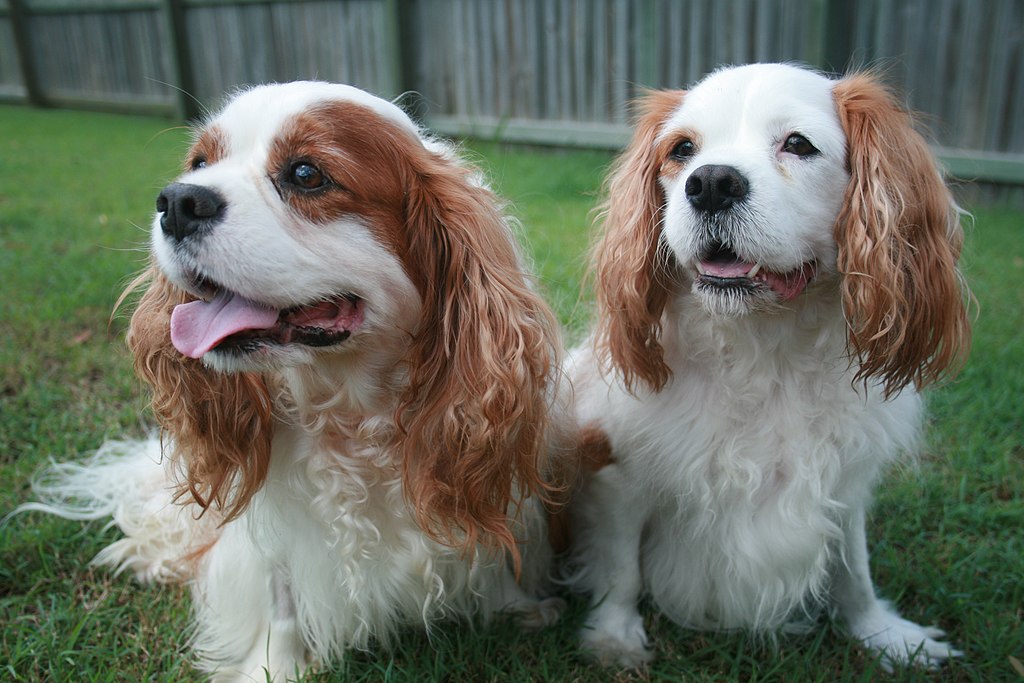 © Wikimedia.org/Kbwatts, CC BY-SA
© Wikimedia.org/Kbwatts, CC BY-SA
The Central Asian Shepherd Dog, also known as the Alabay or Alabai (Turkmen: Alabaý), is a livestock guardian dog breed. Traditionally, the breed was used for guarding sheep and goat herds, as well as to protect and for guard duty. This breed presents a robust dog of greater than average size with great strength and power. They are independent, curious and alert, yet imperturbable. The dog is as long as it is tall at the withers, or slightly longer than its height. The hair is short or moderately long with a heavy undercoat. Its ears are, in practice, cropped very short, and the tail is docked moderately long (except for dogs from countries where cosmetic surgeries for dogs are illegal). Most common colors are black/white; fawn of different shades, from almost white to deep red; brindle. Some have a black mask. (Source: Wikipedia.org, CC BY-SA)
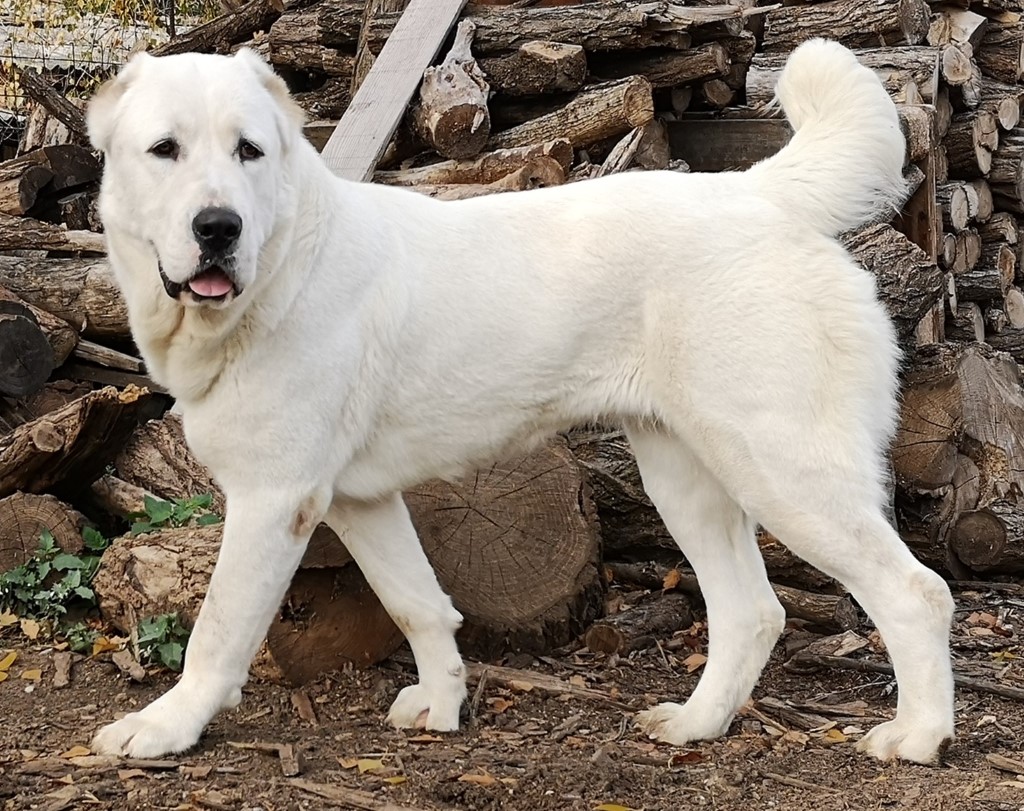 © Wikimedia.org/Halalosirambankiskecskek, CC BY-SA
© Wikimedia.org/Halalosirambankiskecskek, CC BY-SA
The Český Fousek is a Czech breed of versatile hunting dog that was traditionally and currently used to hunt, point, and retrieve. This refers to the dog's natural ability in tracking, pointing, and retrieving game. The name is in Czech, in which český means Czech and fousek is derived from vousy (facial hair) or vousky (whiskers). While the name is used for both sexes, Český Fousek specifically refers to a male dog while the female is traditionally called Česká Fouska. The breed is part of the griffon hunting dog family and have the beard and moustache ('facial furnishings') common to wirehairs. There is a large difference in size between the females and males of this breed, with the weight difference being up to 11 kilograms (24 lb). (Source: Wikipedia.org, CC BY-SA)

Time for recess! Post a comment, ask a question or write a review. Feel free to let us know what you think!
Ben fransada turkce deralere girecem ehliyet ici sinavlari bilen bana yardimci olur mu
Mrhaba bu hafta yaziliya girecem bana yardimci olmak isteyen varmi isvec yazilisina cok korkuyorum yalniz
Orda tabela var otoban başlangıçı icin sorular bunlar Otoyolun başlangıçı Park etmek yasaktır Otobanın başlangıcı Giriş yapmak yasaktır Ben otobanın başlangıçı basıyom yok yanlışmiş otoyolun başlangıçıymız tabi biz türkiyede yaşıyoz unutum ben amk
Elinize sağlık Türkiye'de olmayan birçok levha var.Mantık yürüterek dogru cevapları bulmaya çalıştım.
Gercekten emeginize saglık. Alakasız ve yanlıs birsürü testle karşılaştım, sonunda faydalı bir sayfaya denk geldim.
Merhaba benim Türk ehliyetim var Romanya ehliyeti ile değiştirmek istiyorum nasıl yapabilirim
Dun sinava girdim tek bir soruyla kaybettim dogru bildim konturol ettim 3 soruyu yannis ciklarla cevirdim
HAZIRLAYANLARDAN ALLAH RAZI OLSUN IN$LLH COK GÜZEL-TEK SIKINTI COK AZ TÜRKCE CEVIRIMLERDE AMA OLSUN BEN COK BEGENDIM TE$EKKÜRLER
Bazı sorularda yazımı da aynı olan 2 aynı doğru cevap var. Örnek: Yayalar için yolun sonu. Yerleşim alanının sonu. Bir yerleşim alanının başlangıcı. Yerleşim alanının sonu.